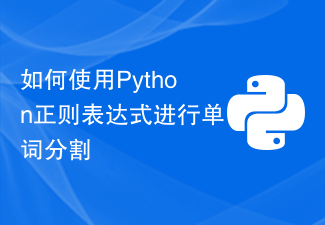
To master the skills of using the position attribute in H5, you need specific code examples
H5 is a markup language used for web design and development, in which the position attribute is One of the important attributes that controls element positioning. In this article, we will discuss several common usage techniques of the position attribute and provide specific code examples.
The position attribute has four optional values: static, relative, absolute and fixed. We'll go over how to use each of these values one by one.
- static (static positioning)
When the element's position attribute value is set to static, the element will be positioned according to the normal document flow. This is the default value of the position property. No special code examples are required.
- relative (relative positioning)
When the element's position attribute value is set to relative, you can set the element relative to its position through the top, bottom, left and right attributes. Offset from normal position. Here is an example:
<style>
.box {
position: relative;
left: 50px;
top: 50px;
}
</style>
<div class="box">相对定位</div>The above code will offset the element 50px to the right and 50px down.
- absolute (absolute positioning)
When the element's position attribute value is set to absolute, the element's positioning will be separated from the normal document flow and based on its nearest non-static The positioned parent element is positioned. If there is no non-statically positioned parent element, the element will be positioned based on the entire page.
Here is an example:
<style>
.parent {
position: relative;
width: 400px;
height: 300px;
}
.child {
position: absolute;
top: 50px;
left: 50px;
}
</style>
<div class="parent">
<div class="child">绝对定位</div>
</div>The above code will position the .child element relative to the .parent element, offset 50px to the right and 50px down.
- fixed (fixed positioning)
When the element's position attribute value is set to fixed, the element will be positioned relative to the browser window. The element remains in a fixed position regardless of whether the page is scrolled or not.
Here is an example:
<style>
.box {
position: fixed;
top: 50px;
left: 50px;
}
</style>
<div class="box">固定定位</div>The above code will make the element offset 50px to the right and 50px down in the upper left corner of the browser window.
In addition to the above four common position attribute values, there are some special usages. For example, using position:sticky can create an effect that automatically fixes an element when scrolling to a specific position. This is a useful feature that can be used to achieve a ceiling effect.
In summary, it is very important for web page layout and design to flexibly master the skills of using the position attribute in H5. By rationally using the position attribute and other related attributes, we can achieve rich and diverse layout effects. I hope the code examples provided in this article will be helpful to readers' learning and practice.
The above is the detailed content of Analysis of usage skills of position attribute in H5. For more information, please follow other related articles on the PHP Chinese website!
 如何使用 Go 语言进行量化金融分析?Jun 11, 2023 am 08:51 AM
如何使用 Go 语言进行量化金融分析?Jun 11, 2023 am 08:51 AM在现代金融领域中,随着数据科学和人工智能技术的兴起,量化金融逐渐成为了越来越重要的一个方向。而作为一门能够高效处理数据和部署分布式系统的静态类型编程语言,Go语言也逐渐受到了量化金融领域的关注。本文将介绍如何使用Go语言进行量化金融分析,具体内容如下:获取金融数据首先,我们需要获取金融数据。Go语言的网络编程能力非常强大,可以用来获取各种金融数据。比
 如何使用PHP开发简单的SEO优化功能Sep 20, 2023 pm 04:18 PM
如何使用PHP开发简单的SEO优化功能Sep 20, 2023 pm 04:18 PM如何使用PHP开发简单的SEO优化功能SEO(SearchEngineOptimization)即搜索引擎优化,是指通过改进网站的结构和内容来提高网站在搜索引擎中的排名,从而获得更多的有机流量。在网站开发中,如何使用PHP来实现简单的SEO优化功能呢?本文将介绍一些常用的SEO优化技巧和具体的代码示例,帮助开发者在PHP项目中实现SEO优化。一、使用友好
 如何使用 Go 语言进行数据挖掘?Jun 10, 2023 am 08:39 AM
如何使用 Go 语言进行数据挖掘?Jun 10, 2023 am 08:39 AM随着大数据和数据挖掘的兴起,越来越多的编程语言开始支持数据挖掘的功能。Go语言作为一种快速、安全、高效的编程语言,也可以用于数据挖掘。那么,如何使用Go语言进行数据挖掘呢?以下是一些重要的步骤和技术。数据获取首先,你需要获取数据。这可以通过各种途径实现,比如爬取网页上的信息、使用API获取数据、从数据库中读取数据等等。Go语言自带了丰富的HTTP
 如何使用nginx进行防盗链Jun 11, 2023 pm 01:25 PM
如何使用nginx进行防盗链Jun 11, 2023 pm 01:25 PM随着互联网的普及,越来越多的网站提供了图片、视频等资源的外链功能。然而,这种外链功能却容易被盗链。盗链是指其它网站利用你网站上的图片、视频等资源,直接通过引用地址在自己的网站显示这些资源,而不是将其下载到自己的服务器上。这样一来,盗链网站就可以免费使用你网站的流量和带宽资源,这既浪费资源又影响网站速度。针对这种问题,可以使用Nginx进行防盗链。Nginx是
 如何使用C#编写最小生成树算法Sep 19, 2023 pm 01:55 PM
如何使用C#编写最小生成树算法Sep 19, 2023 pm 01:55 PM如何使用C#编写最小生成树算法最小生成树算法是一种重要的图论算法,它用于解决图的连通性问题。在计算机科学中,最小生成树是指一个连通图的生成树,该生成树的所有边的权值之和最小。本文将介绍如何使用C#编写最小生成树算法,并提供具体的代码示例。首先,我们需要定义一个图的数据结构来表示问题。在C#中,可以使用邻接矩阵来表示图。邻接矩阵是一个二维数组,其中每个元素表示
 如何使用C++中的分治算法Sep 20, 2023 pm 03:19 PM
如何使用C++中的分治算法Sep 20, 2023 pm 03:19 PM如何使用C++中的分治算法分治算法是一种将问题分解成若干个子问题,再将子问题的解合并起来得到原问题解的方法。它的应用广泛,可以用于解决各种类型的问题,包括数学问题、排序问题、图问题等等。本文将介绍如何使用C++中的分治算法,并提供具体的代码示例。一、基本思想分治算法的基本思想是将一个大问题分解成若干个规模较小的子问题,对每个子问题进行递归求解,最后合并子问题
 如何在ThinkPHP6中使用友好的URL地址?Jun 12, 2023 am 08:52 AM
如何在ThinkPHP6中使用友好的URL地址?Jun 12, 2023 am 08:52 AM随着互联网的发展,越来越多的网站需要考虑优化用户体验,其中一个方面就是友好的URL地址。ThinkPHP是一款优秀的PHP框架,对于URL地址的处理也提供了便捷的解决方案。本文将介绍如何在ThinkPHP6中使用友好的URL地址。首先,我们需要了解下ThinkPHP6中关于路由的相关概念。路由是指将URL请求转发到指定的控制器和方法
 如何使用Python正则表达式进行单词分割Jun 23, 2023 am 10:37 AM
如何使用Python正则表达式进行单词分割Jun 23, 2023 am 10:37 AMPython正则表达式是一种强大的工具,可用于处理文本数据。在自然语言处理中,单词分割是一个重要的任务,它可以将一段文本分成单个单词。在Python中,我们可以使用正则表达式来完成单词分割的任务。下面将以Python3为例,介绍如何使用正则表达式进行单词分割。导入re模块re模块是Python内置的正则表达式模块,首先需要导入该模块。importre定义文


Hot AI Tools

Undresser.AI Undress
AI-powered app for creating realistic nude photos

AI Clothes Remover
Online AI tool for removing clothes from photos.

Undress AI Tool
Undress images for free

Clothoff.io
AI clothes remover

AI Hentai Generator
Generate AI Hentai for free.

Hot Article

Hot Tools

EditPlus Chinese cracked version
Small size, syntax highlighting, does not support code prompt function

VSCode Windows 64-bit Download
A free and powerful IDE editor launched by Microsoft

ZendStudio 13.5.1 Mac
Powerful PHP integrated development environment

MantisBT
Mantis is an easy-to-deploy web-based defect tracking tool designed to aid in product defect tracking. It requires PHP, MySQL and a web server. Check out our demo and hosting services.

SublimeText3 Chinese version
Chinese version, very easy to use






